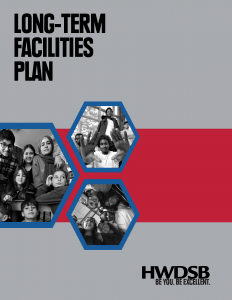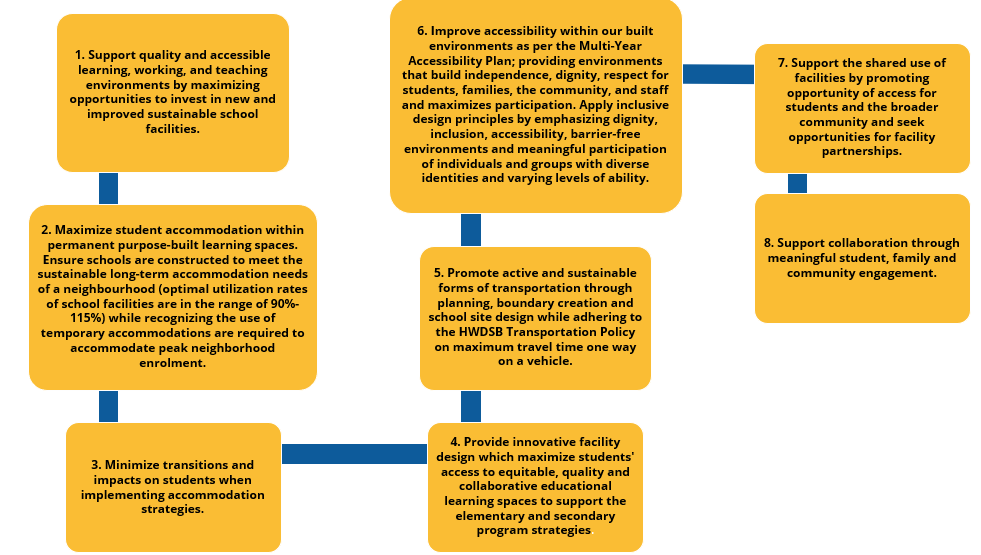
 Hamilton-Wentworth District School Board (HWDSB) is committed to providing equitable, affordable, and sustainable learning facilities for students. To address the numerous facets related to this mandate and to provide clear direction, HWDSB, led by Facility Services, has produced the Long-Term Facilities Plan (LTFP) to guide us in managing and improving HWDSB’s facilities.
Hamilton-Wentworth District School Board (HWDSB) is committed to providing equitable, affordable, and sustainable learning facilities for students. To address the numerous facets related to this mandate and to provide clear direction, HWDSB, led by Facility Services, has produced the Long-Term Facilities Plan (LTFP) to guide us in managing and improving HWDSB’s facilities.
The Long-Term Facilities Plan is meant support and promote the goals of the Multi-Year Strategic Plan, Board Improvement Plan, Human Rights Policy, Multi-year Accessibility Plan, Indigenous Education Circle Strategic Action Plan and other HWDSB Policies.
The LTFP is an online living document with embedded links to websites and reports that will be updated on a regular basis. The goal is to ensure that the LTFP has current and relevant information beyond the date of its publication.
The document is broken down into three main sections which include: Planning and Accommodation, Capital Projects and Facility Operations.
Guiding Principles
To ensure that Hamilton-Wentworth District School Board (HWDSB) provides equitable, affordable and sustainable learning facilities, the following Long-Term Facilities Plan (LTFP) Guiding Principles have been created.
The Guiding Principles are the framework that Facility Services follow when completing capital project submissions, boundary reviews, pupil accommodation reviews, capital projects and long-term capital planning. All recommendations within the Long-Term Facilities Plan are intended to:

Specific Principles related to Elementary and Secondary Panels:
Elementary
- School Capacity – optimal school capacity would be 450 to 650 students, which creates two to three classes for each grade.
- School Grade/Organization – Kindergarten to Grade 8 facilities.
- School Site Size – optimal elementary school site includes play fields, parking lot and building. For new site acquisition, optimal size approximately 6-8 acres and for existing schools, site size is based on local neighbourhood characteristics.
- In dual track schools, enrolment between French Immersion and English track should ensure that the balance supports ideal program delivery. i.e. There should be balance of French and English program enrolments to foster a successful learning experience for every student based upon HWDSB’s elementary program strategy.
Secondary
- School Capacity – optimal school capacity would be 1,000 to 1,400 students.
- School Site Size – optimal secondary school site includes a sports field, parking lot and building. For new site acquisition, optimal size is approximately 13-16 acres and for existing schools, site size is based on local neighbourhood characteristics.
*NOTE: The principles are intended to be guides to inform our work. Local parameters may influence the thresholds above. Further review of the above may take place through the 2025 HWDSB Program Strategy Review
Long-Term Facilities Plan Report
The Long-Term Facilities Plan (Full Report) is broken down into three sections with multiple subsections. Each section represents one of the three divisions that make up Facility Services. The document includes:
Section 1: Planning & Accommodation
1.1 – Community Profile: This section analyzes population, residential development, immigration and live birth trends and their potential impact on enrolment trends.
1.2 – Enrolment & Capacity Trends: This section summarizes student yields and apportionment rates along with historical and projected elementary and secondary enrolment.
1.3 – HWDSB Property: This section provides an overview of Ontario Regulation 374/23: Acquisition and Disposition of Real Property. It also includes a summary of HWDSB properties that are currently for sale, vacant, or declared surplus. In addition, the section outlines HWDSB’s Educational Development Charge (EDC) by-law.
1.4 – Planning Areas: This section provides historic/projected enrolment, maps, facility information and a breakdown of historic and proposed accommodation strategies by elementary and secondary planning area. Planning areas allow for comprehensive and in-depth analysis of each area of the city.
1.5 – Facility Partnerships: This section provides an overview of HWDSB’s facility partnership initiative and schools with surplus space.
1.6 – Accommodation Strategy Schedule: Summarizes accommodation strategies that have been completed since the 2022/2023 school year, and highlights potential future strategies identified by staff. To support detailed planning and analysis, the schedule is organized by individual planning areas.
Section 2: Capital Projects
2.1 – Capital Projects Plan: This section reviews the Annual Capital Plan, elementary/secondary school renewal, school design guidelines and capital funding received since 2012.
2.2 – Facility Assessment: This section provides information regarding how facility assessments are completed, and a description of the classifications used in facility assessment. This section also provides the facility assessment status of all HWDSB schools
Section 3: Facility Operations
3.1 – Facility Operations: This section outlines the HWDSB’s Preventative Maintenance Plan and the Energy Conservation and Demand Plan.
Appendix:
Updated on Monday, September 22, 2025.

